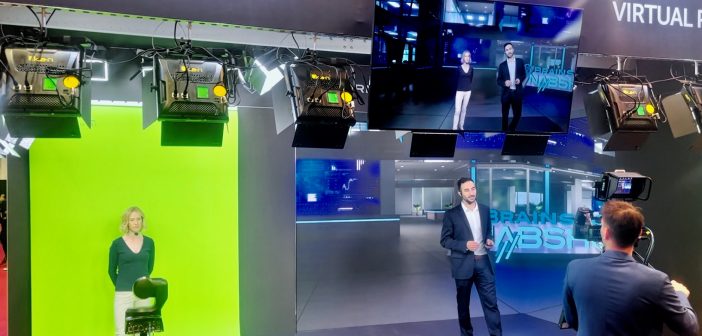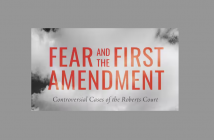The Law and Policy Division of the BEA featured many panels that highlighted many of the most pressing issues in the regulation of First Amendment protected categories and media law. Scholars and practitioners shared several insights about the industry and some pressing issues in our democratic society. As a First Amendment Scholar, I found the insights to be highly valuable to the study of media generally, and the First Amendment in particular. What follows is a highlight of the summary and themes that I think emerged at the conference in the Law and Policy Division presentations. If you are interested in more details, then I suggest you look at the program to inquire with panelists, and also consider attending the conference next year. This is merely my collection of the important takeaways that I found of interest, and that I learned and thought about from the conference. I hope you also find the issues to be of interest to you as we grapple over them in the future.
(1) Artificial Intelligence. With the Rise of New Technology Comes New Disasters. While educators are well aware of the Chatbot GPT form of generating academically dishonest work for students, there are other issues that have emerged with AI, and that were discussed in the Division’s offerings. I’ll cover three that panelists discussed.
First, AI is being used to generate revenge porn. Images of a face or head are fed into an image generating AI bot, and asked to return sexual or pornographic images with the face. When the AI generates the content, the pornographic image is used to exert power over targets.
Second, AI challenges issues concerning copyright material. This occurs, for example, when an AI bot is asked to produce song lyrics in the style and form of a particular artist. To what extent does the artist retain copyright over the style and form? Especially when the style and form defines a genre rather than an artist? If one cannot copyright a genre of music, then what kinds of individual protections may be afforded to individual artists? And, does AI get a copyright since it was the originator of the thought?
Third, there is the issue of AI and wiretapping laws. While shopping online, a chatbot may offer assistance on website home pages. Chatbots are used to generate a conversation with the shopper. Lawsuits currently filed argue that retailers never informed consumers that the chatbots are not really people, nor did the chatbot seek prior consent to be monitored or recorded. Thus, AI may be engaged in illegal wiretapping as regulated by the California Invasion of Privacy Act.
(2) Media Forms Continue to Proliferate. One of the most significant developments is the ATSC 3.0 technology that will transform the way we view and interact with programs on TV. In the next few years, television sets will be transitioning to the ATSC 3.0 technology. This transition will change the way we view television in a number of ways. From what I can tell, there will be upsides of better emergency alert system, better resolution with signals being capable of carrying 4K technology, and more interactivity with programs (ability to browse during a program, click on things during a broadcast for more information, etc.). Of course, we may also see some more controversial capabilities like in-game betting during a broadcast on tv, chat discussions during a show, etc.
While not subject to considerable attention in the program offerings, there were also some hints at the transformative nature of the metaverse and its impact on educational environments. Some people predict that it will be as ubiquitous in education as social media is right now.
Moreover, with the proliferation of podcasts, there were important conversations about the (in)effective use of podcasts as an educational tool. And, members of the Law and Policy Division are considering ways to use podcasts for a variety of purposes. Of the most important considerations are perhaps an emphasis on the high quality of podcast materials, the ability to “captivate” an educational audience, and what specific audiences may be the target of a law and policy podcast.
(3) Government Increasingly Challenges First Amendment Rights. Of course, the idea that governments pass laws that restrict the rights of citizens is not a new phenomenon. The entire history of First Amendment case law is the subject of such debates. One of the more pressing issues concerning rights come with the converging forces of gerrymandering and attempts to regulate freedom of assembly. As gerrymandering becomes more and more a reality, the sense that “the people” can “hold their politicians accountable” becomes less and less a reality. With gerrymandering, the chances for holding a political leader accountable appears to rest on the governing political party itself to remove a particular leader.
Gerrymandering converges with rights when legislators make laws that restrict rights and with potentially no consequences. This is one of the concerns expressed over the proposal in Florida to require those wanting to protest, gather, or hold an event in the capitol to get a sponsor from a government entity. Of course, First Amendment advocates are concerned that this violates the very purpose of the First Amendment—that Congress shall make no law prohibiting the right of the people to peaceably assemble. In other words, First Amendment advocates are worried that if assembly requires government sponsorship, then government may prohibit assembly. And, with gerrymandering, any denial of the freedom of assembly may make it difficult to hold those who refuse the right to peaceably assemble accountable in the electoral process. In short, the government will determine who gets to assemble and who does not.
(4) Intentional Speech Harm Continues to Be Unresolved. To what extent does a speaker have the right to say what they intended by their speech act? On the one hand, we know you cannot yell “fire!” in a crowded theater. Even if you intended it as a joke, the effect of your speech on others outweighs your intent to joke. On the other hand, you have the right to burn a flag and to control your intent of the communication as a critique of the government. In one case, you are subject to the audience’s interpretation of your message. In the other, you have the right to control your intent. Communication is complicated that way. Audiences interpret messages correctly and incorrectly. Speakers are sometimes straightforward, and sometimes say they intend something and lie in order to conceal their “true” intent. On what grounds is interpretive authority administered? This fundamental question has a complex First Amendment history, and is the subject again in Counterman v. Colorado. The Court may finally decide what constitutes a “true threat” when it comes to speech. Must the government prove that the speaker subjectively knew or intended for a statement to be threatening in nature, or does the government need to prove that a “reasonable person” would understand the message to be threatening in nature? We know the Court has faced this question before in cases like Elonis v. United States, but has yet to take a firm stance on the issue. Usually, the Court decides this question on other grounds and kicks the can down the road. One thing is for certain—anti-domestic violence advocates will be paying close attention.
(5) Platform Responsibility Remains Ambiguous When it Comes to Harmful Speech in the Forum. The most popular forms of social media are private platforms in the sense that they are not owned and operated by the government. Because the First Amendment applies to government censorship, the First Amendment does not restrict private entities to censor their platforms. But, are those private social media companies responsible for the speech that they permit to appear on their platforms? This question has been the subject of many cases. Most recently, the two Supreme Court cases of Gonzalez v. Google and Twitter v. Taamneh will weigh in on the issue. Both cases arise from the same set of facts based on the ISIS terrorist attack in Paris, France.
One of our students who attended CSU Long Beach, Nohemi Gonzalez, was studying abroad in Paris, France where she was killed by ISIS terrorists. When ISIS claimed responsibility for the attack, they issued a written statement and posted a video to YouTube. Gonzalez’s father filed an action against Google, Twitter, and Facebook, claiming that they aided and abetted international terrorism by allowing them to use their platform, “to recruit members, plan terrorist attacks, issue terrorist threats, instill fear, and intimidate civilian populations.” One of the specific issues is whether the algorithms that the companies use contribute to sending the messages to specific users that are sympathetic to ISIS and facilitate the spread of its message.
(6) Conventional Media Forms are Increasingly Obsolete. There are a growing list of electric vehicles that are being sold without AM radios. The list includes Audi, BMW, Porsche, Tesla, and Volvo. The list is likely to grow in the coming years, making AM radio fully or near fully obsolete.
In addition, live television is becoming increasingly obsolete with the dominance of On Demand services, individual app popularity (Netflix, Amazon Prime, Disney+, etc.), and the increasing popularity of Youtube TV and Apple TV. The main market for live events is in the sports entertainment area, and even then regional networks are increasingly merging with conglomerates.
(7) Issues of FCC Regulation Continue to Be Complicated. The annual reports to the FCC are sometimes incomplete, and that results in a lot of additional labor on behalf of the Commission. For example, the forms call for annual reports, and the filings sometimes include weekly rather than yearly information. Some reports do not include a response to the nondiscriminatory advertising portion. These are just a couple of examples that require additional resources on behalf of the Commission in order to get the correct information. Thus, there are delays, additional staff required to track down the contact information and other necessary information to complete a given file.
There are some developments that the NAB appear to view as positive, which includes a consortium to provide increased public services to tribal lands in California for things like emergency response and information.
There are also potential issues with FCC regulation when it comes to the transition from ATSC 1.0 to ATSC 3.0 because they have some interference with each other. In the coming years, the way we watch television will change to ATSC 3.0 type of viewing experience that will see more interactivity with programs. So, for example, viewers will be able to do things like click on a portion of a program for more information (i.e., clicking on an actor in a film to see their resume on a pop up). Or, possibly placing bets on the screen of a live sports game without exiting or using a different platform. Or, being able to access a live chatroom on the same screen during a regular television program. In any case, it appears the viewing experience is about to undergo another evolution. As that occurs, it is likely going to be the case that FCC regulation will continue to evolve.
(8) First Amendment Rationales are Used for the Second Amendment, and the Second Amendment May Chill the First Amendment. The Court has analogized Second Amendment rights to First Amendment rights, “Some have made the argument, bordering on the frivolous, that only those arms in existence in the 18th century are protected by the Second Amendment. We do not interpret constitutional rights that way. Just as the First Amendment protects modern forms of communication . . . the Second Amendment extends, prima facie, to all instruments that constitute Bearable arms, even those that were not in existence at the time of the founding.” Thus, the way we interpret First Amendment rights in the modern mediascape has a direct relation to the right to bear arms today. The question that arose from the conference appears to be to what extent does the right to bear arms may implicate First Amendment rights? Second Amendment advocates point to a symbolic speech argument to open carry. That carrying a gun in public is symbolic expression of a person’s idea that they are both willing to defend themselves and of their belief in individual freedom. Those opposed to this view argue that the presence of guns at speech forums negatively chills speech and discourages active participation in speech that is necessary for productive dialogue. Such advocates point to the fact that democratic deliberations and diplomatic conversations do not feature armed congresspeople on the floor of Congress nor armed diplomats that are engaged in peace talks at Camp David.
(9) Psychological Harms are an Increasingly Significant Factor in Harms Experienced in First Amendment Related Events and Press Coverage. Related to the idea of the intent of the speaker versus a “reasonable person’s” interpretation of the speech is the increasing understanding and knowledge of the psychological impacts of First Amendment freedoms. Psychological research has long been controversial as the basis for limiting First Amendment freedoms or in the context of exercising First Amendment freedoms. For example, First Amendment scholars have long been aware of the debate about violent video games and their impact in cases like Brown v. EMA which upheld the right of violent video game sales. There is a growing body of psychological literature about the effects of hate speech on the psychological state of historically marginalized communities. In addition, there is increasing evidence of PTSD in the press industry as professionals are covering gruesome and horrific events in live coverage. Thus, we may begin to see a couple things that may be necessary: (1) First Amendment tests that protect people from psychological harm as the studies become better and better, and (2) the likely need for support programs for reporters who suffer PTSD in their career so that they might continue to exercise the freedom of press in the service of an informed citizenry.
In Conclusion: An Anecdote of the Value of Academic Conferences
One of the purposes of writing this piece is to highlight the value of attending academic conferences. Conferences are not only a space of presenting academic research. They provide educators a kind of update about the most pressing issues in the field of study, and a space to consider emerging themes that are critical to educating our students about the most recent issues that affect our everyday lives. Supplementing our existing research with the most pressing research that is in the process of being written and (un)published provides a valuable service to furthering the goal of an educated democratic society. Institutions that continue to devalue conference funding do so at the risk of providing a stale educational environment. That stale environment may not happen overnight, but the effects of a stale environment may possibly be unknown until it is too late. Education must be continually nurtured, and academic conferences are an essential component to such nurturance. They invigorate and energize researchers to examine the challenges of our world, and specifically at this conference, face the challenges presented in today’s mediascape and beyond.
There are many things to be learned from an academic conference like that provided by the Law and Policy Division of BEA. If institutions do not support travel by faculty to present their research, then these conversations become less incentivized. Attending such conferences serves as a valuable way to increase civic engagement and a more informed citizenry. They are a vital part of our democratic life.
Kevin A. Johnson, Ph.D.
Director, Center for First Amendment Studies
California State University, Long Beach
April 25, 2023




